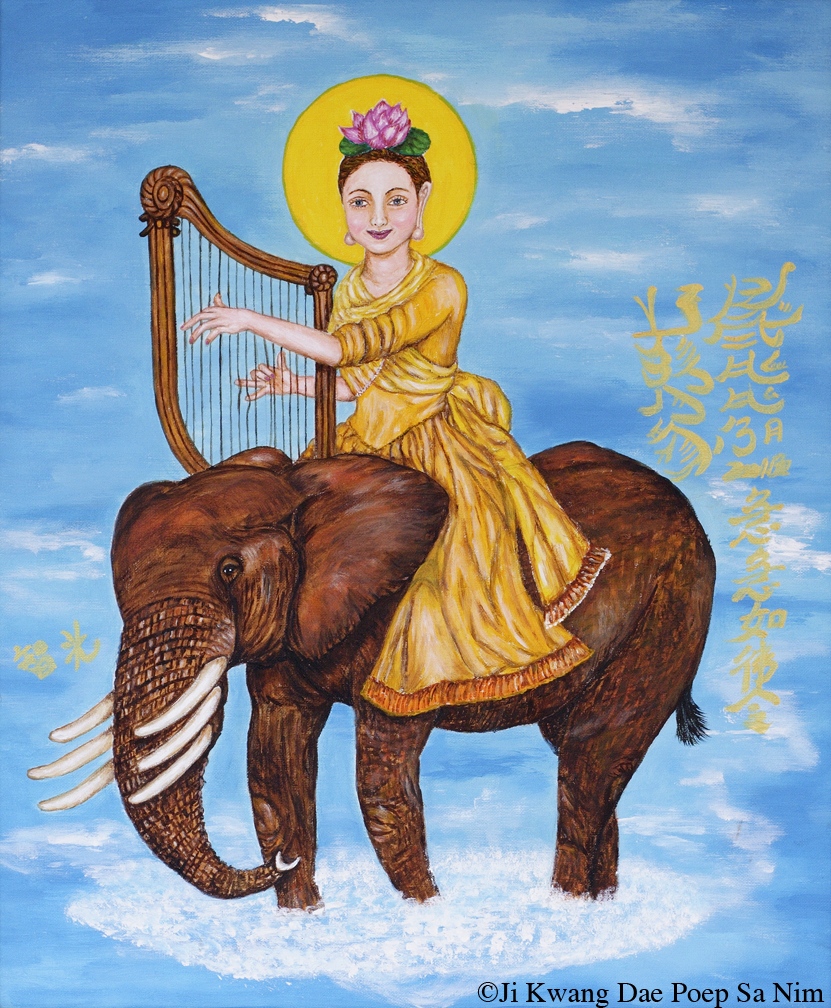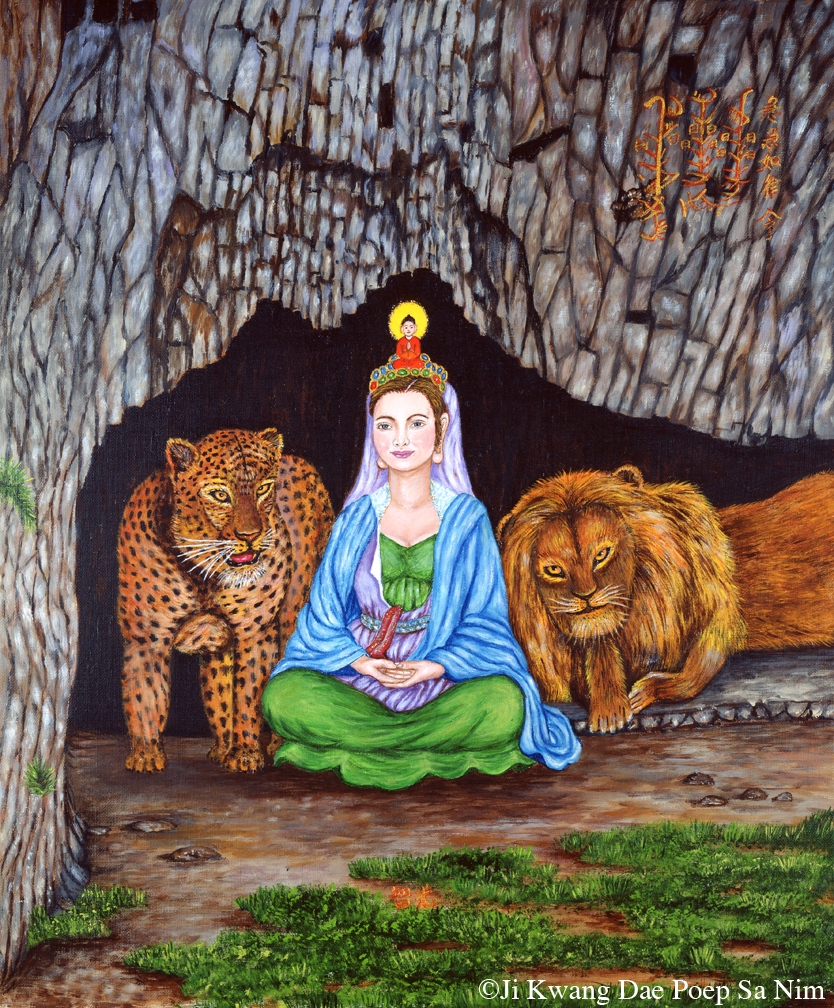About the Art
Dae Poep Sa Nims paintings cannot be considered as ordinary artistic paintings because in each one is a spiritual writing with very special energy. Each picture is created from her enlightened mind, from the place of absolute clarity and truth, and is for a specific purpose.
Their divine penetration power and beauty is a great benefit for its owner and his/her family, and will be so generation after generation. Indeed, the reason she paints them is for the benefit and help people receive through them. They help people attain the truth, to be healed, to be protected, to have prosperity, to be tranquil, to foster beautiful and correct relationships, etc.
Dae Poep Sa Nim said that having one of these paintings is like having a temple and energy center in ones home. The energy and blessings which she puts into each painting help to balance ones mental and physical energy, so one can become clear, and go in a correct and positive direction.


Comments
From the Writer and Journalist Alberto Vinyoli
Whoever has been to an exhibition of the paintings of Supreme Matriarch Ji Kwang Dae Poep Sa Nim knows that Her paintings go far beyond what we usually understand as art. Her Spiritual Energy Writing Paintings bring to art history a new approach and dimension that has been needed for a long time.
Show More
Art is usually considered mainly from the point of view of form. Depending on the particular painting, we say its style is either impressionistic, abstract, baroque, naive, classic, and so on. After that, one’s attention goes towards the name of the particular artist, the time the painting was made, etc. Even if we receive some kind of energy while in front of a painting that we see in a gallery or museum, we are almost never aware of it. On the contrary, as soon as we see Supreme Matriarch Ji Kwang Dae Poep Sa Nim’s paintings we are made completely aware of the energy they have and relay to us.
From the point of view of form, we may consider that her paintings belong to the naive art style because of the directness with which their initial meaning is transmitted. In these paintings we see, for example, a lion as a lion, an elephant as an elephant, a smiling face as a smiling face. Right away we are brought to simplicity through her precise technique that washes away any obstacles between the painting and the viewer. We immediately discover the beauty there and we also feel that the artist strongly wants to make us comfortable. We immediately feel at ease. Next, we understand that the form and color of the painting are not the main thing but are an open door (reinforced by the golden calligraphies) through which energy flows.
This is why it is impossible to talk about the artwork of Supreme Matriarch Ji Kwang Dae Poep Sa Nim without talking about the energy they transmit. It is impossible to talk appropriately about that energy without having a certain level of spiritual realization. Nevertheless, that we can enjoy and be benefited by their energy is most important. This is the main purpose of Her paintings. We could even say that they are practical art because in addition to enjoying them from the artistic point of view, the energy of the place and person who owns one changes and everything begins to work correctly. This is due to the clarity and truth from which these paintings are created. We must not forget that Supreme Matriarch Ji Kwang Dae Poep Sa Nim is a fully enlightened great spiritual master.
The paintings of Ji Kwang Dae Poep Sa Nim are holy and sacred. They all transmit clear spiritual messages right into our homes. She uses Her artwork as a means to help and benefit others and to express to the world that attaining true happiness and peace are really possible. Her Spiritual Energy Writing Paintings are alive and show us these things.
This new level of the art has been needed for a long time. It has finally arrived. Thank you very much Supreme Matriarch Ji Kwang Dae Poep Sa Nim!
From Dr. Sabine Huschka
Having two of Supreme Matriach Ji Kwang Dae Poep Sa Nim’s precious Energy Spiritual Writing Paintings is like being mentally nourished with love and fresh energy from the second we enter our home and every moment we are there. The title of one of our painting is exactly that: “Nourishing Love”.
Show More
Changes that one can feel directly occur not only where our paintings hang but throughout our home. Even people who do not know anything about the origin of the paintings or Supreme Matriach Ji Kwang Dae Poep Sa Nim can feel the special energy that surrounds and emerges from the paintings. This sounds like magic and in a sense it is. I cannot explain scientifically how the process of sending energy through the paintings works, but I can describe the effect, since we have experienced it clearly for some years now and we have had several crucial experiences with other people (and now even animals) who stayed in our house.
Some guests like to lay down on the floor directly in front of the paintings. They choose those places for a short nap even though they are not physically the most comfortable places for resting. Our sofa, for example, would be more comfortable. When some people who work with us in our house arrive they are at times very tired and tight. However, when they leave they are more refreshed than before, even though they worked for some hours. One time a worker who was looking for water lines under our house was immediately impressed by the “high voltage energy” that flows out from the paintings. He said that the energy of the paintings is so pure and strong and that all possible atmospherical interferences are equalized.
The title of each painting says what it is for and what the person(s) who have it will be or what they will receive. What the title expresses will come true. This is not something one has to believe in, but is something one will experience.
Thank you very much Dae Poep Sa Nim.
From Mr. Peter Hershock, Ph.D.
This article was written by Mr. Peter Hershock, who has been a student of Ji Kwang Dae Poep Sa Nim since 1986 and is one of Her disciples. Mr. Hershock has earned degrees from Yale University (B.A., Philosophy) and the University of Hawai’i (Ph.D., Asian and Comparative Philosophy). He is Coordinator for the Asian Studies Development Program at the East-West Center in Honolulu, Hawai’i, and a professor of philosophy.
Show More
Most artists paint in order to express themselves or to make a statement about some aspect of the world that they feel deserves the attention of others. Especially in contemporary art, there is often a conscious attempt to do so in ways that raise questions about the meaning and history of art, as well as about the viewer’s relationship to them. Such works of art, even though they may be abstract, surreal, or highly conceptual, still serve to represent some understanding or experience of the artist. They place something before the viewer who must then take in, decode, and understand its message. In postmodern language, most works of art function as signs. In a common phrase from Zen Buddhism, they are “like fingers pointing at the moon”.
Of course, this is nothing new. Especially in the West, art works have long been understood as symbolic in nature. And, indeed, it was for this reason, nearly 2,500 years ago, that Plato dismissed the art of painting as irrelevant or misleading for those intent on realizing truth and beauty. With the irony so characteristic of postmodern life, this is a claim that has come to be embraced by many artists today who see art as a way of explicitly challenging the meaning of “truth” and “beauty” and even “meaning” itself.
The paintings of Ji Kwang Dae Poep Sa Nim have their roots in a very different tradition. Although it is possible to see her paintings as evocative of primitivist, impressionist, and even surrealist sensibilities, they seem to me to have greater affinity with the East Asian traditions of calligraphy, landscape painting, and the practices associated with sacred icons and mandala or meditative devices.
From earliest times in China, and later in both Korea and Japan, writing was associated with mediating between the human realm and that of the sacred or spiritual. Writing was not originally for the purpose of mundane communication, but served to bring about community between the celestial and the human through the manifestation of shared meaning. In part, this is why calligraphy came to be regarded as the preeminent form of art in East Asia. Calligraphy was understood to be a direct demonstration of spiritual force and virtue a demonstration of a person’s profound capacity for harmonizing with their situation, but also for bringing about harmony within a situation. For this reason, all great leaders in East Asia have traditionally been expected to demonstrate calligraphic skill.
In East Asian calligraphy, the written word becomes a vehicle for bringing into direct presence both transformative energy and insight. The calligraphic work is thus not an artistic representation of a particular word with a particular meaning. It is the live recording of performative realization occurring in a specific place, at a specific time.
This sensibility came to inform the canons of Chinese landscape painting in the Tang and Sung dynasties. Influenced by both Buddhism and Daoism, landscape painters strove to so fully and clearly relate to the natural scenes they painted that the energy (or qi) of the mountains, streams, valleys, trees, and rocks would literally be recorded on silk with ink. Instead of resting primarily on representational skill, masterful landscape painting was understood as arising through an artist’s ability to establish clear and open sympathetic resonance (ganying) with nature. The importance cannot be overstated of sympathetic resonance in traditional Chinese culture – in correlative cosmology, medicine, theories of governance, and social harmony, for instance. But it was also crucial to Chinese understandings of religion and the efficacy of sacred art and ritual.
Sacred art in East Asia generally served two interwoven purposes. As evident in Buddhism, the first was to embody or make present spiritually significant figures, the most common of these being particular Buddhas or bodhisattvas who had vowed to help all those who would call upon them in sincere need. The second purpose was to provide a vehicle for meditative training and a means for realizing attentive virtuosity (known in Buddhism as samadhi) and wisdom.
The paintings of Ji Kwang Dae Poep Sa Nim bring together all three of these East Asian artistic tradition and extend them in a way that is, to my knowledge, utterly unique. To begin with, although Her paintings are often figurative, in the strict sense of the word, they do not represent anything. They do not place before us an image of something. They are not signs or indications of something lying beyond the canvas in the usual sense. To shift metaphors, these paintings are not like recipes. They are feasts – orchestrated by a master chef – into which we can enter and actually taste the meaning of true virtuosity and wisdom. Ji Kwang Dae Poep Sa Nim’s paintings place before us live recordings of Her own attentive mastery, great compassion, and unlimited capacity for skillfully unblocking relational patterns that have become conducive to suffering.
In this sense, although the paintings are in many cases explicitly figurative, their function is not to represent some individual person(s), some ideal, or some archetypal relationship. Instead they serve to actively restore the originally pure and clear meaning of the relationships through which we have come to be as we are. They are vehicles for healing and illuminating patterns of sympathetic resonance.
The characters ji and kwang can be translated as the “effulgence of wisdom” or “brilliantly shining realization”. The paintings of Ji Kwang Dae Poep Sa Nim, the Supreme Matriarch of the Yun Hwa Denomination of World Social Buddhism, allow Ji Kwang – effulgent wisdom – to enter our own lives and do there the healing and compassionate work of transforming this world into a Buddha-realm in which all things may do the great work of enlightenment.
Peter Hershock, Ph.D.
Honolulu, U.S.A

A teaching from
Supreme Matriarch Ji Kwang Dae Poep Sa Nim
3,951. April 4, 2003. Yong Ho San Dharma Sah
Human energy is always connected with nature energy. So according to ones individual karma, one comes into this world and lives his life according to this karma. However, with practice, one eliminates his individual negative karma and, as a result, one lives a better life and can really attain true happiness life after life.
There is a second karma, which determines the place where one is born. But more important than ones place of birth is where one grows up and ones place of living. If where one grows up is a good energy place, which means it is a good feng shui place, then one becomes a better human being than one would have become if he had only his own karma to go by. That is why from ancient time people always look for the good energy place, because when they live there, their body and mind are comfortable and with their good actions they can eliminate past and present karma.
Wherever I go, I look at the feng shui of the place or country. Of course every place is different. Even in the Hawaiian Islands the energy is different between islands. For example, when we compare Honolulu with Hilo, which is where our monastery is, their energies are different. Honolulu energy is much more like competition energy. In Honolulu, there are many different mountains, and they are all poky shaped. In Hilo, where our monastery is, there are only very few, very high and very round mountains, which are spiritually very strong mountains. Even non-practitioners know that the Big Island, where Hilo is, is the most strong spiritual island. That is why from ancient times, practitioners usually go to such high mountains and there they practice to become clear.
Because of the present world situation, I have been asked to help Honolulus well being. That is why today I came to Honolulu to bless and to balance the energy here. Even in Honolulu, there are good and bad energy places. For example, whenever young people come to study in our Honolulu temple, they all study very well and become honor students. Even if one lives in a not so good energy place, if the energy of that place can be balanced, then the people who live there will benefit. That is why from ten years ago, because I was so often being asked by people to balance the energy of their house or working place, I started making the energy spiritual writing paintings. These paintings balance the place where they are and balance the peoples energy and benefit their individual karma and their lives, so that they can attain clarity and prosperity and receive help to go on the path of truth.

